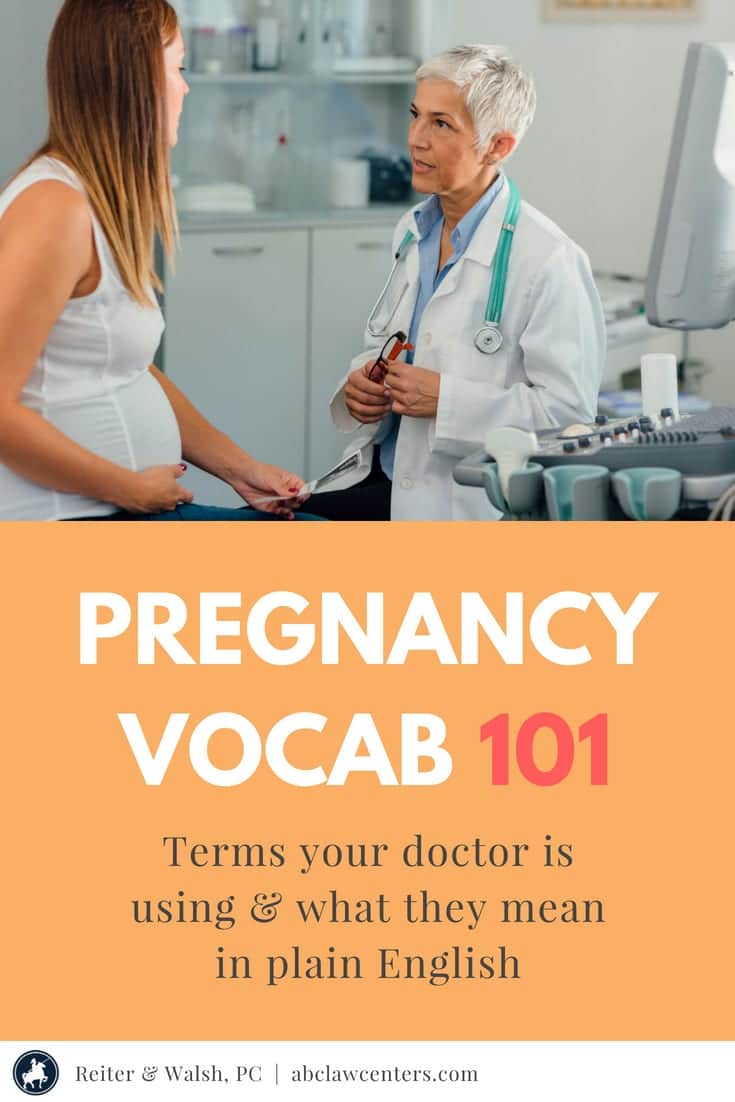During their education, doctors learn “medical jargon.” This refers to words and phrases that are useful when communicating with other medical professionals, but may be very confusing to patients.
The best doctors are careful not to overwhelm their patients with complicated terminology. They use simple language to explain what is going on (unless the patient already has a lot of knowledge about medicine). They will also encourage patients to ask questions. Talking to your doctor should feel like a conversation — not a lecture in a language you have never studied!
Unfortunately, many doctors put less effort into how they explain things to patients, leaving many patients are hesitant to ask for clarification. It is very important to know that it’s part of your doctor’s job to make sure you understand your health and the choices that you have.
However, you may try to learn a bit of pregnancy vocab, so you can more easily follow conversations between your doctors. Learning medical terms can also help with reading medical information in books or on websites. Here, we’ll define common terms used when talking about pregnancy. Check back for more posts defining jargon related to other topics in maternal-infant health!
Medical Vocab Related to Pregnancy Health

Amniocentesis: A prenatal test in which a small amount of fluid is taken out of the amniotic sac for analysis.
Amniotic sac: The amniotic sac is inside of the uterus, and is sort of like a bubble that protects the growing baby. It is filled with a liquid called amniotic fluid. The amniotic sac ruptures shortly before a baby is born, and the amniotic fluid comes out of the mother’s vagina.
Birth canal: The birth canal includes several parts of the mother’s body, through which a baby must pass during vaginal birth. It includes the uterus/womb, cervix, vagina, and vulva.
Braxton Hicks Contractions: Braxton Hicks contractions are also called “false labor.” They occur when the uterus tightens briefly, basically as practice for actual labor. Braxton Hicks contractions most commonly occur late in pregnancy (in the third trimester). If you are unsure whether you are having real contractions or Braxton Hicks — contact your doctor ASAP for more information!
Cervix: The cervix is the lowest part of the uterus, which connects to the vagina. Babies must pass through the cervix in order to be born vaginally.
Cesarean section (C-section): A surgery in which doctors make a cut into the mother’s abdomen and deliver the baby.
Conception: Conception is the moment when a woman becomes pregnant. It occurs when a man’s sperm joins with a woman’s egg, fertilizing it. If a doctor asks when conception occurred, or when a pregnancy was conceived, they mean the date that the mother and father had sex, resulting in pregnancy (it could also mean the date that in-vitro fertilization occurred). Doctors may ask the date of your last period; this information can be used to estimate the date of conception.
Due date: A woman’s “due date” is when her baby is expected to be born. Doctors can estimate a due date using the date of conception and/or the date of a woman’s last period, or by doing an ultrasound.
Eclampsia: Eclampsia is a pregnancy condition in which a woman’s high blood pressure (see preeclampsia) leads to problems such as convulsions (shaking), coma, and even death. It must be treated very quickly.
Is your baby in the NICU?
Complications from birth injuries can be due to medical negligence. Our dedicated nurses are available 24/7 to listen to your story.
Embryo: An embryo is a baby in the very early phase of development when it still looks like a clumping of cells or a fish-like creature. Generally, the term embryo is used between weeks 2 and 8 of pregnancy.
Epidural: A type of anesthesia (a medication to decrease feeling) that can relieve pain during childbirth.
Fallopian tubes: A pair of tubes from which a woman’s eggs travel from the ovaries (where eggs are produced) into the uterus (where babies grow during pregnancy).
Fetus: A fetus is the term used for a developing baby from after the 8th week of pregnancy until birth.
Full-term birth: Exact definitions for full-term birth vary, but it is when a baby is born close to 40 weeks of pregnancy. Sometimes, doctors may talk about “early-term birth” and “late-term birth,” which have more specific definitions.
Gestation: Gestation is just another word for pregnancy.
Maternal hemorrhage: A maternal hemorrhage is heavy bleeding from the vagina when a woman is pregnant, giving birth, or has recently given birth. A hemorrhage can be a very serious medical problem, and must be treated quickly.
Induction of labor: This is when a doctor begins labor artificially, either by giving the mother drugs (for example Pitocin) or by breaking the amniotic sac (an amniotomy). There are risks associated with labor induction, so it should only be done when necessary.
In-utero: In-utero simply means “inside the uterus.” Another term for the uterus is the “womb.”
In-vitro fertilization (IVF): In-vitro fertilization is a way that a woman can become pregnant without having sexual intercourse with a man (sometimes, women also have in-vitro fertilization because they are unable to become pregnant through sex, or because their partner has fertility problems). “In-vitro” means “in glass” and “fertilization” means that a sperm joins with an egg. During IVF, sperm and eggs are taken out of the parents, combined in a glass container, and then put into the mother’s uterus.
Labor: When a woman goes into labor, that means her body is getting ready to give birth. Labor begins with the start of uterine contractions.
Miscarriage: A miscarriage is when an embryo or fetus dies before it would be able to survive outside of the mother’s uterus (womb). Most doctors say it is a miscarriage if the death happens before 20 weeks of pregnancy.
Multiples pregnancy: A multiples pregnancy is when a woman is pregnant with twins, triplets, or more.
Obstetrician: A doctor who specializes in caring for pregnant women and their babies.
Placenta: The placenta is an organ inside of the uterus, which supplies nourishment (food) to the growing baby. The placenta and the baby are connected to each other by the umbilical cord.
Postterm pregnancy: A postterm pregnancy is when a baby has not yet been born after 42 weeks of pregnancy. This is often dangerous for mothers and babies, so doctors may recommend that a mother have her labor induced or that her baby be born via Cesarean section if her pregnancy is getting close to postterm.
Preeclampsia: Preeclampsia is a pregnancy complication in which the mother’s blood pressure becomes dangerously high. Sometimes (especially if not properly treated) it progresses to eclampsia, which is a medical emergency.
Premature birth: A premature birth, also known as preterm birth, is when a baby is born before 37 weeks of pregnancy. If they can, doctors will try to prevent premature births. Premature babies (aka “preemies”) are at higher risk for serious medical problems since their organs and immune systems are underdeveloped.
Prenatal: Prenatal means ‘before birth’. Other words with the same meaning include antenatal and antepartum. Doctors often talk about prenatal tests, which are tests performed during pregnancy to check the health of the mother and/or baby.
Presentation: When doctors mention a baby’s presentation, they are talking about the way that a baby is positioned inside of the uterus (womb). Near the end of pregnancy, a baby’s positioning provides information about whether they are likely to be born vertex (head first), breech (feet first). In some cases, babies with abnormal presentations may need to be born through a Cesarean section.
Rupture of membranes: The term “rupture of membranes” is more often known as a woman’s “water breaking.” It occurs just before birth, when fluid rushes out of the vagina. That fluid is not actually water, it is amniotic fluid. During pregnancy, the baby grows in amniotic fluid inside of the amniotic sac. After the amniotic sac breaks, the fluid rushes out and the baby can be born.
Birth injury law — it’s all we do!
Our dedicated on-staff nurses are always ready to listen to your story. Our attorneys are have 25+ years of experience handling birth injury cases.
Stillbirth: A stillbirth is when a fetus dies after approximately 20 weeks of pregnancy (exact definitions vary).
Trimesters: In pregnancy, there are three trimesters. The first trimester is approximately the first three months of pregnancy. Pregnancy symptoms, including morning sickness (nausea and vomiting), exhaustion, and headaches, are common in the first trimester. The second trimester is approximately the middle three months of pregnancy. Women usually start “showing” during the second trimester and begin to feel their babies move. The third trimester is approximately the last three months of pregnancy. During the third trimester, women usually have frequent checkups with their doctors to prepare for delivery. Parents also spend time preparing for childbirth and the arrival of their babies.
Ultrasound: An ultrasound is a type of test that uses sound waves to show pictures of your baby inside the uterus (womb). It can help doctors see how the baby is developing. It can also be used help to determine whether the baby is a boy or a girl.
Umbilical cord: The umbilical cord connects the growing baby to the placenta. It carries nutrients (food) and oxygen to the baby, and can also remove the baby’s waste products.
Uterine contractions: Uterine contractions, sometimes just called “contractions,” happen when muscles in a woman’s uterus tighten and shorten. This helps make room for the baby to go through the birth canal.
About Our Team

ABC Law Centers: Birth Injury Lawyers was established in 1997 to focus exclusively on birth injury cases. While some children with birth injuries make a complete recovery, others develop lifelong disabilities such as cerebral palsy, hypoxic-ischemic encephalopathy (HIE) and seizure disorders like epilepsy.
If your child’s birth injury and subsequent disability could have been prevented with proper care – this is medical malpractice. Settlements from birth injury cases can cover the costs of lifelong therapy treatments, extensive medical care, and other crucial resources like accessible housing upgrades.
If you believe that your child’s birth injury was caused by medical negligence, contact us today. We are available 24/7 to talk to you free of any obligation or charge. In fact, our clients pay nothing throughout the entire legal process unless we win.